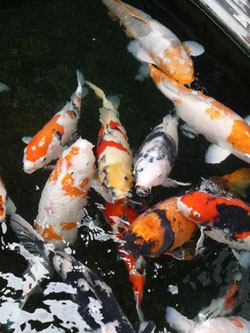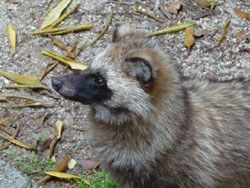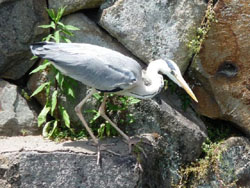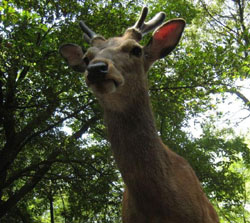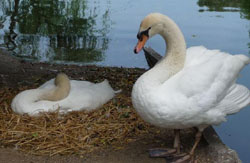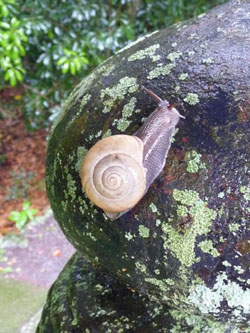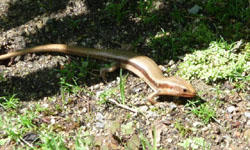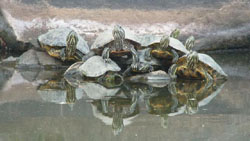Wildlife on your doorstep
By Mark Brazil | Oct 18, 2009
Get out with your camera and your best shots could be shown here.To be brutally honest, wildlife photography is mostly about having the means to get to amazing places, where wildlife still abounds. Then it takes heaps of patience. And the final ingredient is a good eye to capture the moment.
Oh, yes, and a camera. But these days, digital cameras are reasonably priced. No longer do you need an SLR (single-lens reflex) camera to take great wildlife shots. Today, so many small-bodied cameras have optical zoom lenses up to 10-, 18- and even 20-times magnification, and the quality just keeps getting better.
But my first tip, if you are thinking of buying a new camera, is don’t be seduced by awesome numbers when it comes to digital zoom. Digital zoom is rubbish. You’ll be so disappointed with the quality you will never want to show your pictures to anyone: stick to optical zoom, and don’t forget that the close-up or macro function is lots of fun and very useful for taking pictures of plants, insects or other invertebrates.
Getting a great wildlife shot can involve painstaking research, much time spent locating your chosen subject, and then tremendous patience while waiting for it to be where you want or to do what you want.
Conversely, it can be pure serendipity. Perhaps you happen to have your camera out hoping for one thing, when something else amazing happens. Or perhaps you just luck into a great situation, have a camera at hand and can snap the shot. Either way, a winning shot can be the result of hours of work, or just seconds of luck.
If you can afford to go on safari to southern Africa, if you can visit the Pantanal in Brazil, have the cash to splash on a trip to Antarctica, or can explore the wilds of the Russian Far East, then the odds are that you are going to come back with some fantastic images of creatures doing their own thing.
I am one of the lucky ones; I get to go to those sorts of places for my work — but I still find it hard to come up with original shots that will make an editor jump. However, it’s my consolation that I consider myself to be a writer, and a photographer only as a distant second.
But what if you are not that lucky? What if an overseas trip is out of the question and a destination an hour’s train ride away is the furthest you have time to escape to? Do you have to give up on wildlife photography? Heck no! You just need to think outside the box.
First of all, one person’s exotic location is someone else’s local patch. For those of us here in Japan are already in a dream location for untold thousands living in other parts of the world. Here in Japan, we are also blessed with considerable biodiversity, giving us loads of subjects to choose from. What is more, Japanese cities generally either have urban parks and castles with moats, or they are surrounded by tea fields, rice fields or forested hills. Then there are all those tree-ringed temples or shrines.
Additionally, of course, some cities have zoos, though I am not so keen on them for wildlife photography. That said, even though zoo life isn’t truly wild, zoos can be great places to observe the behavior of smaller creatures. Don’t even think about watching the larger creatures, because their behavior is too often stereotyped because of their cramped quarters. In fact, do what you can to persuade your local zoo to trade down in size.
For instance, an enclosure that is way too cramped for even a single large mammal such as an elephant or a giraffe, will easily house a whole colony of fascinating creatures such as meerkats. There, they will have plenty of space to roam, and will hugely entertain visitors with their behavior — but I digress.
If escaping into the countryside to follow a nature walk, hike a mountain trail or even stroll along farm tracks between fields doesn’t appeal to you, then focus on your local park or the grounds of your local temple or shrine. There, in these pocket-size “nature reserves,” you may be amazed at what you find — and incidentally discover how much fun wildlife photography can be.
To give a few examples of what is possible, here are some of the subjects I have photographed in city parks or at tourist spots in Japan this year.
In the garden at Ryoanji (The Temple of the Peaceful Dragon) in Kyoto, I found a photogenic group of Reeve’s pond turtles, and at Niijo Castle there I came across Chinese soft-shelled turtles, while a Japanese five-lined skink posed for me in the city’s Tenryuji Sogenchi garden.
Then, over in Shimane Prefecture, I came across Red-eared sliders stacked up in the moat of Matsue Castle, while a colony of Grey herons was nesting in trees beside the same castle, and there were psychedelic koi carp in a nearby canal. Another Grey heron entertained me as it fished beside the canal in Kurashiki City, Okayama Prefecture, where I photographed a pair of Mute swans nesting in full view beneath a small bridge.
Speaking of Grey herons, though, my favorite this year was one that posed like a statue in front of the famous stone lantern in the Kenroku-en garden in Kanazawa, Ishikawa Prefecture. In contrast, a tanuki Raccoon dog moved fast and nervously as it came out into full view a short walk behind the shrine at Miyajima in Hiroshima Prefecture, where there were Sika deer in abundance.
Wonderful snails there were, too, glistening in the rain at Usa Shrine in Oita Prefecture, and if I’d had the time I could have “bagged” any number of butterflies, dragonflies and other insects.
So here’s my challenge for you, budding or accomplished photographers alike: As we head into winter, grab your digital camera and head out to a local park, beauty spot or tourist trap. Try and keep within the one-hour limit if you travel away from home by train. Become an incidental wildlife photographer.
Seize the moment, whether it’s a butterfly or cicada, a mammal, a bird, a slug or a worm — and don’t limit yourself to basic portraits!
Be creative, think behavior, think unusual angles, or focus on patterns; zoom in on fur, scales, feather details or unusual creatures — and let’s see the results.
You have all of autumn and winter to fire away, and to select from your collection. Send in your best five shots taken between now and spring to the e-mail address below, complete with captions and your home postal address. I will review all the submissions with a small panel of judges and run the very best of them in this column next year.
We’ll make the cutoff date March 31, 2010, for entries, and I’ll throw in a copy of one of my books for the winner as a prize. Give it your best shot!

